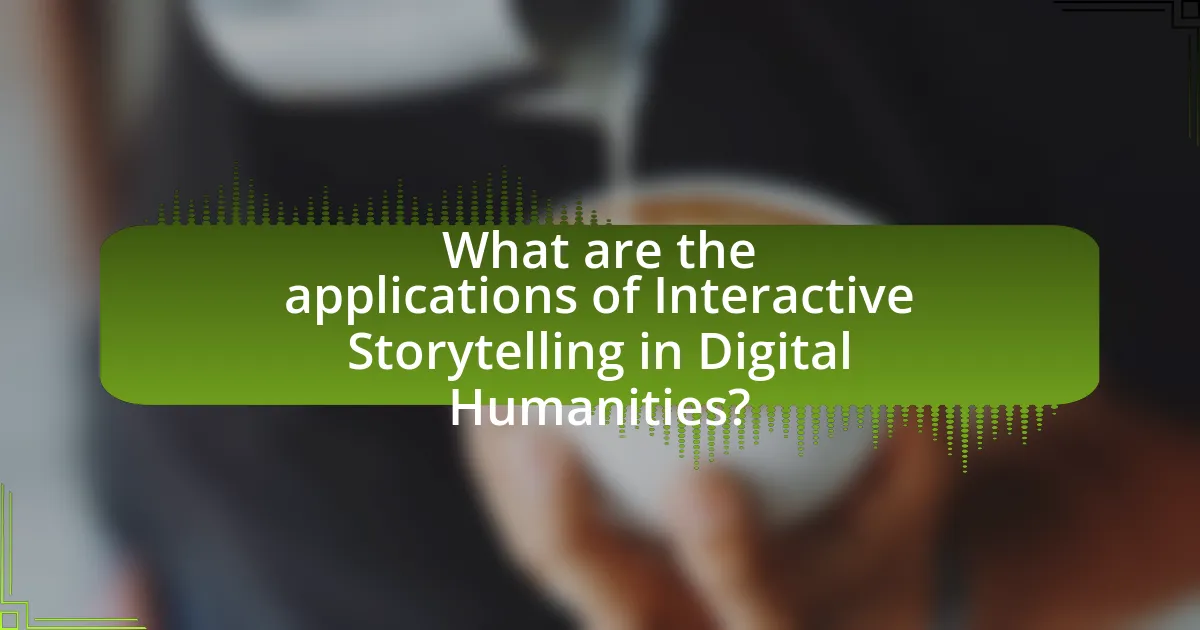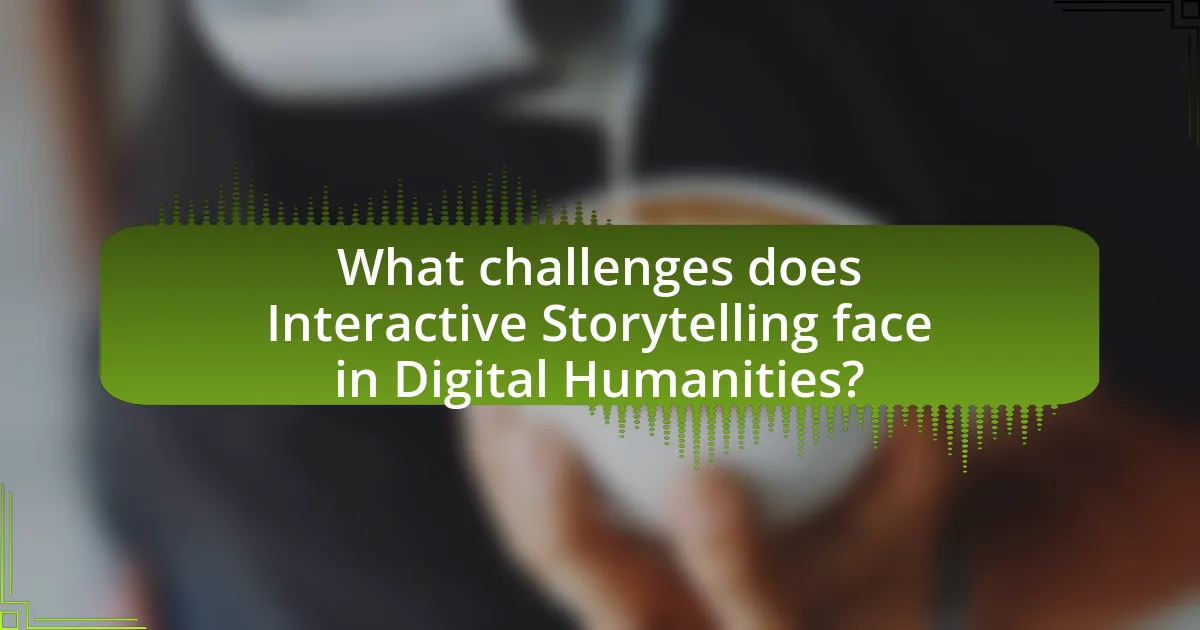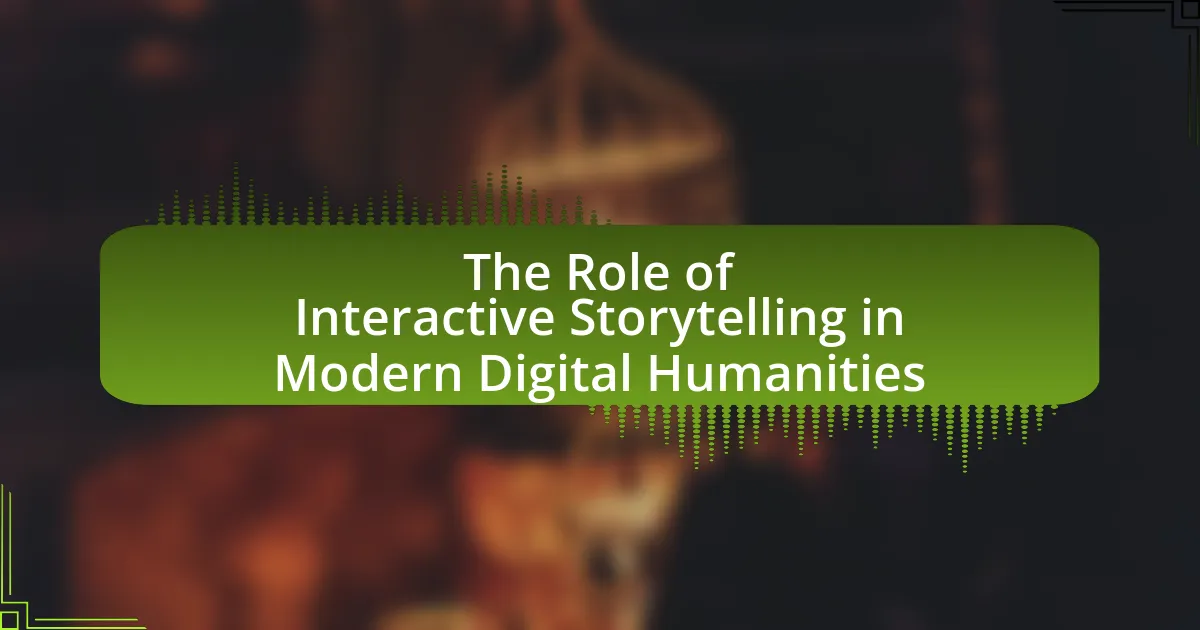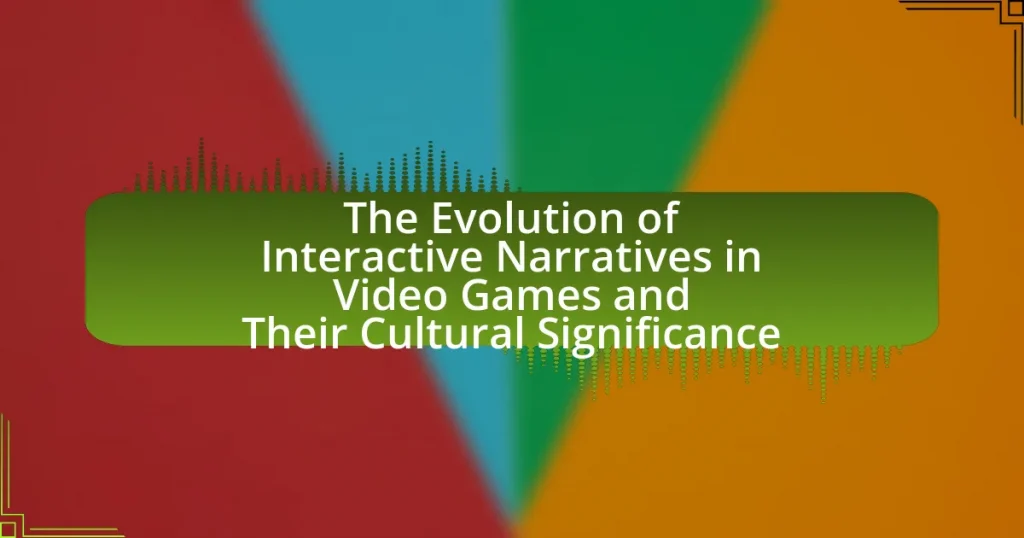Interactive storytelling in modern digital humanities leverages digital technologies to create narratives that allow user interaction and participation, enhancing traditional storytelling through multimedia elements. This approach fosters deeper engagement and critical thinking, making it a valuable tool in educational and cultural contexts. Key elements defining interactive storytelling include user agency, narrative branching, and immersive environments, which collectively influence narrative outcomes and enhance user experiences. The article explores the significance of interactive storytelling in engaging audiences with cultural narratives, its applications in education, and the challenges it faces, including technological limitations and ethical considerations. Additionally, it discusses best practices for creating effective interactive storytelling experiences and the tools available for developers in this evolving field.

What is Interactive Storytelling in Modern Digital Humanities?
Interactive storytelling in modern digital humanities refers to the use of digital technologies to create narratives that allow for user interaction and participation. This approach enhances traditional storytelling by integrating multimedia elements, such as text, audio, video, and interactive interfaces, enabling users to influence the direction and outcome of the story. Research indicates that interactive storytelling fosters deeper engagement and critical thinking, as users actively shape their experiences, making it a valuable tool in educational and cultural contexts. For instance, projects like “The Night Cafe” utilize virtual reality to immerse users in a narrative environment, demonstrating the potential of interactive storytelling to transform how stories are told and experienced in the digital age.
How does interactive storytelling differ from traditional storytelling?
Interactive storytelling differs from traditional storytelling primarily in its emphasis on audience participation and choice. In interactive storytelling, the narrative evolves based on the decisions made by the audience, allowing for multiple outcomes and personalized experiences. This contrasts with traditional storytelling, where the narrative is linear and predetermined by the author, offering a single, fixed storyline. Research indicates that interactive storytelling can enhance engagement and emotional investment, as seen in video games and interactive films, where players’ choices directly influence the plot and character development. This participatory nature fosters a deeper connection between the audience and the narrative, highlighting the transformative potential of interactive storytelling in modern digital humanities.
What are the key elements that define interactive storytelling?
Interactive storytelling is defined by key elements such as user agency, narrative branching, and immersive environments. User agency allows participants to make choices that influence the story’s direction, creating a personalized experience. Narrative branching refers to the multiple pathways a story can take based on user decisions, enhancing engagement and replayability. Immersive environments provide a rich context that draws users into the narrative, often utilizing multimedia elements like visuals, audio, and interactivity to deepen the experience. These elements collectively enhance the storytelling process, making it dynamic and participatory, which is essential in the context of modern digital humanities.
How does user interaction influence narrative outcomes?
User interaction significantly influences narrative outcomes by allowing individuals to make choices that shape the direction and development of the story. In interactive storytelling, each decision made by the user can lead to different plotlines, character arcs, and endings, thereby creating a personalized experience. Research indicates that this dynamic engagement enhances emotional investment and immersion, as users feel a sense of agency over the narrative. For instance, studies have shown that games like “The Walking Dead” and “Life is Strange” utilize branching narratives where user choices directly affect character relationships and story progression, demonstrating the tangible impact of user interaction on narrative structure.
Why is interactive storytelling significant in the context of digital humanities?
Interactive storytelling is significant in the context of digital humanities because it enhances user engagement and fosters deeper understanding of cultural narratives. This form of storytelling allows individuals to actively participate in the narrative, thereby transforming passive consumption into an interactive experience that promotes critical thinking and personal connection to the material. Research indicates that interactive storytelling can lead to improved retention of information and a more profound emotional response, as evidenced by studies showing that users who engage with interactive narratives demonstrate higher levels of empathy and comprehension compared to traditional storytelling methods.
What role does it play in engaging audiences with cultural narratives?
Interactive storytelling plays a crucial role in engaging audiences with cultural narratives by allowing them to actively participate in the story, thereby enhancing emotional investment and personal connection. This participatory approach transforms passive viewers into active participants, fostering a deeper understanding of cultural contexts and themes. For instance, studies have shown that interactive narratives can increase empathy and retention of cultural knowledge, as participants navigate choices that reflect diverse perspectives and experiences. This engagement is supported by research from the University of Southern California, which found that interactive storytelling can significantly enhance audience engagement and emotional response compared to traditional storytelling methods.
How does it enhance the study of humanities through technology?
Interactive storytelling enhances the study of humanities through technology by providing immersive experiences that engage users in narrative exploration. This engagement allows for deeper understanding of cultural contexts and historical narratives, as users can interact with content in a way that traditional methods do not permit. For instance, platforms like Twine and StoryMapJS enable users to create and navigate complex narratives that reflect diverse perspectives, fostering critical thinking and empathy. Research indicates that interactive storytelling can improve retention of information and encourage active participation, as evidenced by studies showing that learners retain 50% more information when engaged in interactive formats compared to passive learning methods.

What are the applications of Interactive Storytelling in Digital Humanities?
Interactive storytelling in digital humanities is applied in various ways, including enhancing user engagement, facilitating educational experiences, and preserving cultural heritage. By allowing users to interact with narratives, projects like “The Night Cafe” enable immersive exploration of historical contexts, while platforms such as “StoryMapJS” help visualize geographical and temporal data through storytelling. Additionally, interactive storytelling fosters collaborative research, as seen in initiatives like “Digital Public Library of America,” which encourages community contributions to narrative construction. These applications demonstrate how interactive storytelling enriches the digital humanities landscape by making complex information accessible and engaging.
How is interactive storytelling used in educational settings?
Interactive storytelling is used in educational settings to enhance engagement and facilitate deeper learning experiences. This method allows students to actively participate in narratives, making choices that affect the story’s outcome, which fosters critical thinking and problem-solving skills. Research indicates that interactive storytelling can improve retention rates; for instance, a study by the University of Southern California found that students who engaged with interactive narratives scored 20% higher on assessments compared to those who experienced traditional storytelling methods. This approach not only makes learning more enjoyable but also encourages collaboration and communication among students, further enriching the educational experience.
What are some successful examples of interactive storytelling in education?
Some successful examples of interactive storytelling in education include “Zombies, Run!” and “The Night Cafe.” “Zombies, Run!” is a mobile app that combines running with an immersive narrative, engaging users in a story while promoting physical activity; it has been used in educational settings to encourage fitness and teamwork. “The Night Cafe,” an interactive virtual reality experience based on Vincent van Gogh’s artwork, allows students to explore art history in an engaging way, enhancing their understanding of the subject through experiential learning. Both examples demonstrate how interactive storytelling can effectively enhance educational outcomes by fostering engagement and deeper learning experiences.
How does it facilitate experiential learning in humanities subjects?
Interactive storytelling facilitates experiential learning in humanities subjects by immersing learners in narrative-driven environments that encourage active participation and critical thinking. This method allows students to engage with historical events, cultural contexts, and philosophical concepts through interactive scenarios, enhancing their understanding and retention of complex ideas. For instance, studies have shown that learners who participate in interactive storytelling experiences demonstrate improved empathy and analytical skills, as they navigate choices and consequences within the narrative framework. This approach not only makes learning more engaging but also fosters a deeper connection to the material, as evidenced by research indicating that experiential learning can lead to higher levels of student motivation and achievement in humanities disciplines.
What impact does interactive storytelling have on cultural preservation?
Interactive storytelling significantly enhances cultural preservation by allowing diverse narratives to be shared and experienced in immersive ways. This method engages audiences emotionally and intellectually, fostering a deeper understanding of cultural heritage. For instance, projects like “The Night Journey,” which combines video game mechanics with storytelling, enable users to explore and interact with historical narratives, thereby preserving and revitalizing cultural stories that might otherwise be forgotten. Additionally, research indicates that interactive storytelling can increase community involvement in cultural heritage projects, as seen in initiatives that encourage local participation in creating digital narratives. This participatory approach not only documents cultural practices but also empowers communities to maintain their cultural identity in a rapidly changing world.
How can it help in documenting and sharing cultural heritage?
Interactive storytelling can significantly aid in documenting and sharing cultural heritage by providing immersive experiences that engage users with historical narratives and cultural practices. This method allows for the integration of multimedia elements, such as audio, video, and interactive visuals, which enhance the understanding and retention of cultural information. For instance, platforms like StoryMapJS enable users to create narratives that combine maps and stories, effectively illustrating the geographical context of cultural heritage sites. Research indicates that interactive storytelling fosters deeper emotional connections to cultural content, making it more memorable and impactful for audiences.
What technologies are commonly used in these storytelling projects?
Common technologies used in storytelling projects include virtual reality (VR), augmented reality (AR), interactive web platforms, and multimedia authoring tools. VR and AR enhance immersive experiences, allowing users to engage with narratives in a three-dimensional space, as evidenced by projects like “The Night Cafe” which utilizes VR to recreate Vincent van Gogh’s art. Interactive web platforms, such as Twine and StoryMapJS, enable creators to build nonlinear narratives that users can navigate, exemplified by the interactive storytelling project “The Wilderness Downtown.” Multimedia authoring tools like Adobe Creative Suite facilitate the integration of text, audio, and video, enhancing the storytelling experience. These technologies collectively contribute to the evolution of digital humanities by enabling richer, more engaging narratives.

What challenges does Interactive Storytelling face in Digital Humanities?
Interactive storytelling in digital humanities faces several challenges, including technological limitations, user engagement, and narrative coherence. Technological limitations arise from the need for advanced platforms that can support complex interactive narratives, which may not be widely accessible or affordable. User engagement is critical, as creators must design experiences that captivate diverse audiences, often requiring extensive user testing and iteration. Additionally, maintaining narrative coherence becomes difficult when allowing for multiple user choices, which can lead to fragmented stories that may confuse or disengage users. These challenges highlight the need for ongoing research and development in the field to enhance the effectiveness of interactive storytelling within digital humanities.
What are the technical limitations of interactive storytelling?
The technical limitations of interactive storytelling include constraints in narrative complexity, user interface design, and technological accessibility. Narrative complexity is often limited by the need for branching storylines, which can lead to inconsistencies and a lack of coherence in the overall plot. User interface design can hinder engagement if it is not intuitive or fails to accommodate diverse user preferences, impacting the storytelling experience. Additionally, technological accessibility poses a challenge, as not all users have access to high-performance devices or stable internet connections, which can restrict participation in interactive storytelling experiences. These limitations are supported by studies indicating that user engagement drops significantly when narrative coherence is compromised or when interfaces are not user-friendly.
How do these limitations affect user experience and engagement?
Limitations in interactive storytelling significantly hinder user experience and engagement by restricting narrative depth and interactivity. When users encounter rigid storylines or lack of meaningful choices, their emotional investment diminishes, leading to disengagement. Research indicates that narratives with limited interactivity can result in a 30% decrease in user satisfaction, as users feel less empowered to influence outcomes. Furthermore, if the technology fails to support seamless interaction, users may experience frustration, which negatively impacts their overall enjoyment and willingness to participate. Thus, these limitations directly correlate with reduced engagement and a less immersive experience in digital humanities projects.
What solutions are being explored to overcome these challenges?
Solutions being explored to overcome challenges in interactive storytelling within digital humanities include the development of adaptive narrative frameworks that allow for personalized user experiences. These frameworks utilize algorithms to analyze user choices and adjust storylines accordingly, enhancing engagement and educational value. Additionally, collaborative platforms are being created to facilitate interdisciplinary partnerships among technologists, artists, and scholars, fostering innovative storytelling techniques. Research indicates that such collaborations can lead to richer narratives and more effective educational outcomes, as seen in projects like “The Interactive Fiction Technology Foundation,” which promotes tools and resources for interactive storytelling.
How do ethical considerations influence interactive storytelling?
Ethical considerations significantly influence interactive storytelling by shaping the narratives, character development, and player choices to ensure responsible representation and engagement. These considerations guide creators to avoid perpetuating stereotypes, promote inclusivity, and respect cultural sensitivities, thereby fostering a more equitable storytelling environment. For instance, the inclusion of diverse perspectives in narratives can enhance empathy and understanding among players, as seen in games like “Life is Strange,” which addresses themes of mental health and identity. Furthermore, ethical frameworks encourage transparency in how player data is used, ensuring that user privacy is respected, which is crucial in maintaining trust within interactive experiences.
What are the potential risks of misrepresentation in narratives?
The potential risks of misrepresentation in narratives include the distortion of facts, which can lead to misinformation and misunderstanding among audiences. Misrepresentation can result in the reinforcement of stereotypes, as seen in media portrayals that inaccurately depict certain groups, leading to societal biases. Additionally, it can undermine the credibility of the storyteller or the medium, as audiences may become skeptical of narratives that do not align with their experiences or known facts. Historical examples, such as the portrayal of events in biased documentaries, illustrate how misrepresentation can shape public perception and influence cultural narratives negatively.
How can creators ensure inclusivity and diversity in storytelling?
Creators can ensure inclusivity and diversity in storytelling by actively incorporating diverse perspectives and experiences into their narratives. This can be achieved through research and collaboration with individuals from various backgrounds, ensuring representation of different cultures, genders, abilities, and socioeconomic statuses. For instance, studies show that diverse teams produce more innovative ideas and solutions, which can enhance storytelling quality and relatability. Additionally, creators can utilize feedback from diverse audiences to refine their narratives, making them more inclusive and reflective of a broader range of human experiences.
What are best practices for creating effective interactive storytelling experiences?
Best practices for creating effective interactive storytelling experiences include engaging the audience through meaningful choices, ensuring a coherent narrative structure, and utilizing multimedia elements to enhance immersion. Engaging the audience with meaningful choices allows participants to influence the story, fostering a sense of agency and investment. A coherent narrative structure is essential, as it provides a clear progression and context for the audience’s decisions, which can be supported by frameworks like the Hero’s Journey. Utilizing multimedia elements, such as visuals, audio, and interactivity, enhances immersion and emotional connection, as evidenced by studies showing that multimedia storytelling can increase retention and engagement rates by up to 60%. These practices collectively contribute to a more impactful and memorable interactive storytelling experience.
How can creators balance narrative depth with user interactivity?
Creators can balance narrative depth with user interactivity by integrating branching storylines that allow for meaningful choices while maintaining a cohesive narrative structure. This approach enables users to influence the story’s direction without sacrificing the richness of the narrative. For instance, games like “The Witcher 3” exemplify this balance, offering players choices that impact character development and plot outcomes, thereby enhancing engagement while preserving narrative complexity. Research indicates that interactive storytelling can enhance user immersion and emotional investment, as seen in studies by Murray (1997) in “Hamlet on the Holodeck,” which highlights the potential of interactive narratives to deepen user experience.
What tools and platforms are recommended for developing interactive stories?
Twine, Inklewriter, and StoryMapJS are recommended tools and platforms for developing interactive stories. Twine is an open-source tool that allows users to create nonlinear stories through a visual interface, making it accessible for both beginners and experienced developers. Inklewriter offers a user-friendly platform specifically designed for writing interactive narratives, enabling authors to focus on storytelling without needing extensive programming knowledge. StoryMapJS is ideal for creating stories that incorporate maps, allowing users to present narratives in a geographical context. These platforms are widely recognized in the digital humanities for their effectiveness in facilitating interactive storytelling.



